Parts of Reviews You Might Not Want to Read Crossword
Putting together a book willy nilly won't become you the volume sales you're looking for. If you lack the right parts of a volume, yours volition look low quality, and it won't sell (or get good reviews).
Y'all know what you want to write near…
What yous don't know is which parts of a book are actually necessary in your book.
Getting this wrong tin make y'all look like a existent amateur instead of a credible professional—which is what you lot really want.
Right?
Knowing which parts of a book to include in yours and which don't make any sense starts with knowing what they are to brainstorm with.
These are the parts of a book you need & what we'll cover in detail for yous:
Click to bound to that section.
- Book Cover
- Title Page
- Copyright
- Tabular array of Contents
- Dedication
- Foreword
- Prologue
- Epilogue
- Epigraph
- Volume introduction
- Inciting incident
- Sections of a volume
- Human action construction
- First slap
- Second slap
- Climax
- Acknowledgements
- Author bio
- Coming before long / Read more
- Synopsis
What are the parts of a volume? TEMPLATE
Design and content make up the entirety of the book, including the title, introduction, trunk, conclusion, and back encompass.
In order to write a book in full, you need to have all the moving parts to brand information technology not only good but also effective.
Without essential pieces, your book will appear unprofessional and worse: you'll lose the credibility and say-so writing a book is so useful for.
Parts of a Volume You Need for Success
Information technology's not enough to just write and self-publish a volume by throwing information technology up on Amazon or whatsoever other publishing site.
You have to get the parts of your book right if you want information technology to sell more, get those five-star reviews, and place yous every bit an authorisation effigy in your field.
Hither's how to do that.
#i – Volume Comprehend
Every book needs a bully book embrace. Every bit much as nosotros'd love to remember people don't but a book by its comprehend…they do.
Having a quality book cover is amidst 1 of the best ways you lot can ensure your volume sells well, specially as a self-published author. It'southward the commencement matter they see, and a potential buyer tin form an opinion in seconds.
Here'due south an example of a full, front-to-back strong book cover that fits the tone, style, and contents of a book titled The Politically Homeless Christian past Aaron Schafer.

#two – Title Page
For obvious reasons, your title is important…
Merely that'due south not all that'southward important to your book. The title page is too necessary and without it, your book will be missing something crucial.
Your title folio serves as a means of non simply declaring your championship clearly, just too ensuring your name, subtitle, endorsement, and any other crucial information is nowadays for your readers to view clearly.
Here's an instance of a great title page and what you tin can use to replicate your ain from I Wish Everyone Was an Immigrant past Pedro Mattos:

As you tin can run into, the title folio is really simply the main title, whatsoever subtitle you may accept, and the writer's name every bit the bottom.
Other than this being an industry standard for books, it helps to keep everything clear without the obstruction of any title images.
#3 – Copyright
Your volume needs to exist copyrighted. Unless you're okay with others stealing its content and reaping the rewards for themselves, that is.
We have a great guide on what it takes to copyright a volume right here for y'all to view, simply here are some of the nuts.
- Technically a book is copyrighted as you write it. But if you want it to be fully legal, y'all exercise accept to pay to accept information technology copyrighted.
- Your copyright content will alter depending on the blazon of book y'all're writing.
- There are certain copyrights y'all cannot have exclusive rights to depending on what you cover in your book, which is usually impacted the most by what you write in a memoir and its legality
Here's an example of what a copyright section of a book may look like:
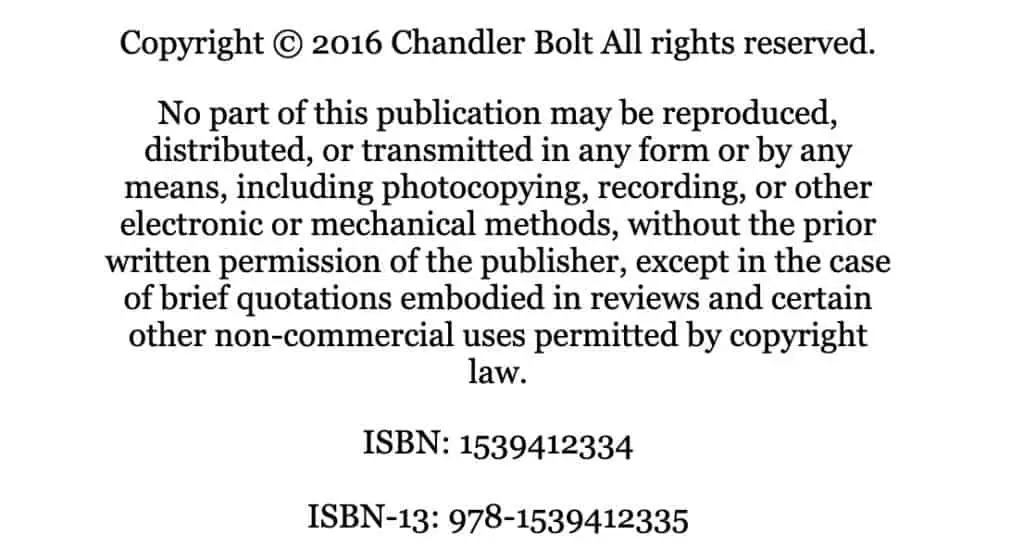
#4 – Table of Contents
There are a lot of reasons to have a table of contents in your volume. For one, it helps readers know where to notice the information they're really looking for.
Secondly, this is highly useful in kindle or ebook versions of your volume in order to help readers click and navigate without having to actually arrow over through the pages in order to get at that place.
The happier the reader, the better the reviews they go out.
What is a table of contents?
A table of contents is a list of a book's chapters or sections with the heading proper noun and often the folio number if in that location are no links within.
Hither's an example of this role of a book:
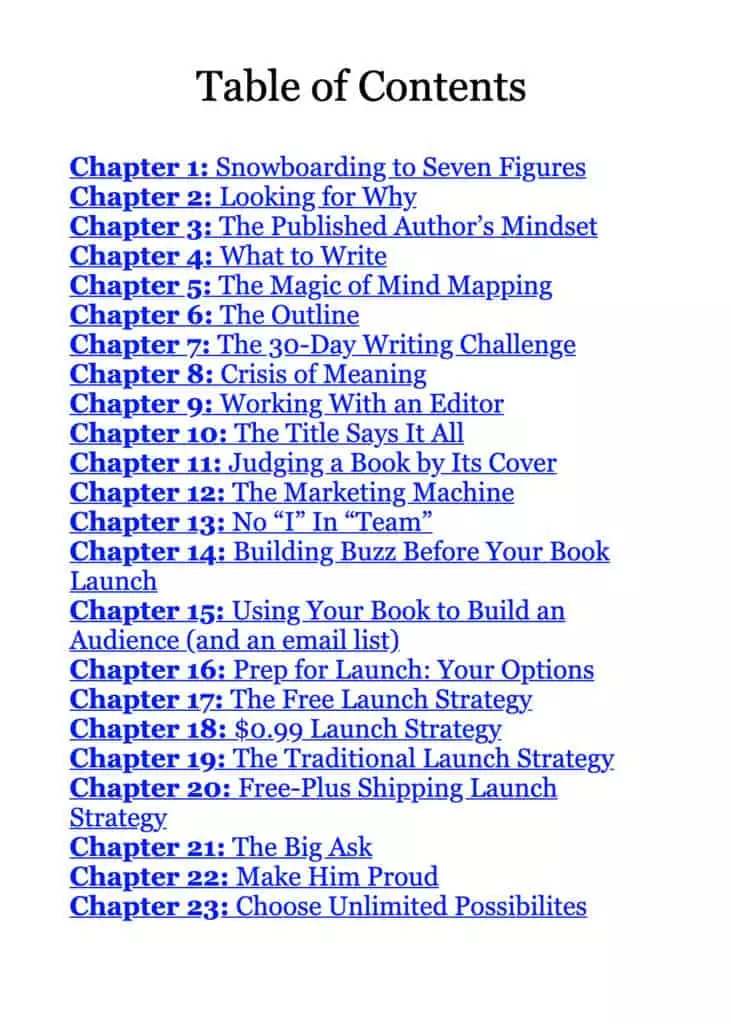
#5 – Dedication
This is the part of a book that most of usa write long earlier the actual book is finished…we just tend to jot it downwardly in our minds instead of on paper.
Your volume dedication is like your acceptance speech when given an award. Except your volume is the award and therefore, y'all become to write this "voice communication" and identify it where everyone can read it before even starting the book.
This defended often comes later the championship folio and before the table of contents.
It's a short few sentences thanking whomever helped you go to the indicate of writing the book or merely people you lot want to admit as thank you.
This is an instance what a dedication of your book may wait like from our own Educatee Success Strategist Pedro Mattos's debut novel I Wish Anybody Was an Immigrant:
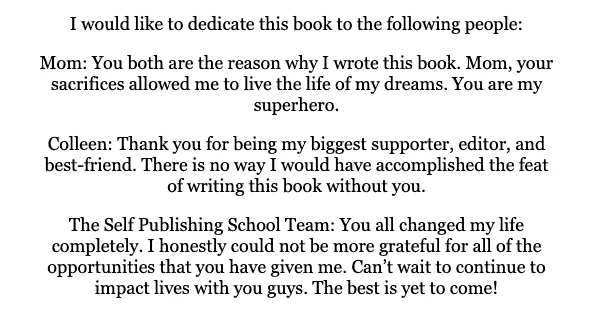
#half dozen – Foreword
If you're looking to increase your credibility, go a book endorsement past someone who knows you and your story well, so a foreword is what you desire.
What is a foreword?
A foreword is an introduction to a book written past someone other than the author that lends credibility to the writer's status to write the volume.
Think of a foreword equally a sort of endorsement of the volume. The person who writes information technology is unremarkably an writer themselves, though they can also but exist a person of dominance in the aforementioned or similar field.
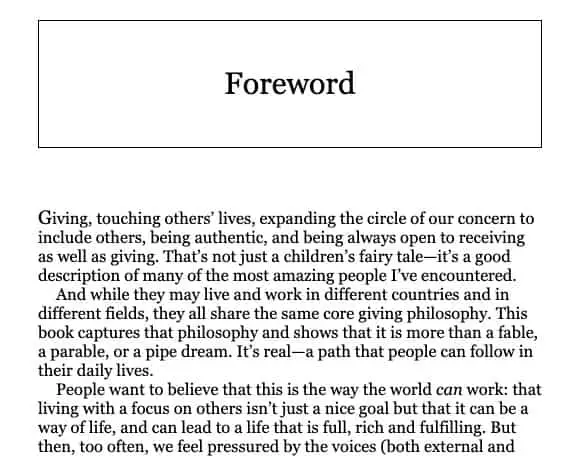
Higher up is an case of a foreword from The Go-Giver by Bob Burg.
Forewords typically come after the table of contents and earlier the introduction or get-go chapter of the book.
#7 – Prologue
Fiction is where prologues live. Oftentimes, stories may demand additional context before the actual story begins in order for the reader to brand sense of it and elements within the book itself.
What is a prologue?
A prologue is a short chapter that usually takes place before the primary story begins as a ways of granting understanding to the reader. It's besides used to increase intrigue and captivate readers.
Not all books require prologues and in fact, if yous can write your novel without it, that's really preferred as many readers skip the prologue altogether.
Beneath is an instance of a prologue from the very popular Game of Thrones by George R.R. Martin.
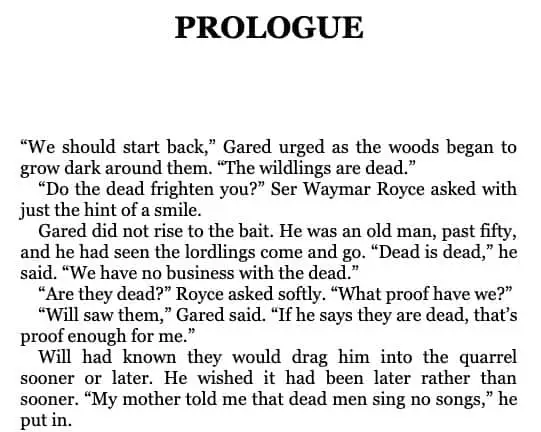
#8 – Epilogue
Not all volume series get happily-ever-afterwards endings. When your book serial ends but yous desire a way to permit the readers know what'southward in store for the characters' futures, an epilogue is a potent way to do that.
What is an epilogue?
An epilogue is a short affiliate that comes later the last affiliate of a volume as a way to necktie the story together in a determination.
Substantially, the epilogue is the answer to the question, "what happens to them side by side?" This serves as a more than satisfying manner to let readers know that characters live "happily ever afterward."
Sometimes the catastrophe of the story isn't satisfying enough for readers.
That part of their story may end, but if your readers want a more in-depth look at their life "later on" the story, that'southward when an epilogue would come into play to tie everything together.
#9 – Epigraph
Epigraphs aren't necessarily important, nor are they required. Often, these short snippets serve every bit a way to let readers know what lesson or subject will exist covered in the chapter.
What is an epigraph?
An epigraph is a short question, quote, or even a poem at the beginning of a chapter meant to indicate the chapter'south theme or focus. This often ties the current piece of work to predecessors with similar ideas and learnings.
For example, below is an epigraph from The 7 Habits of Highly Effective People past Stephen R. Covey.
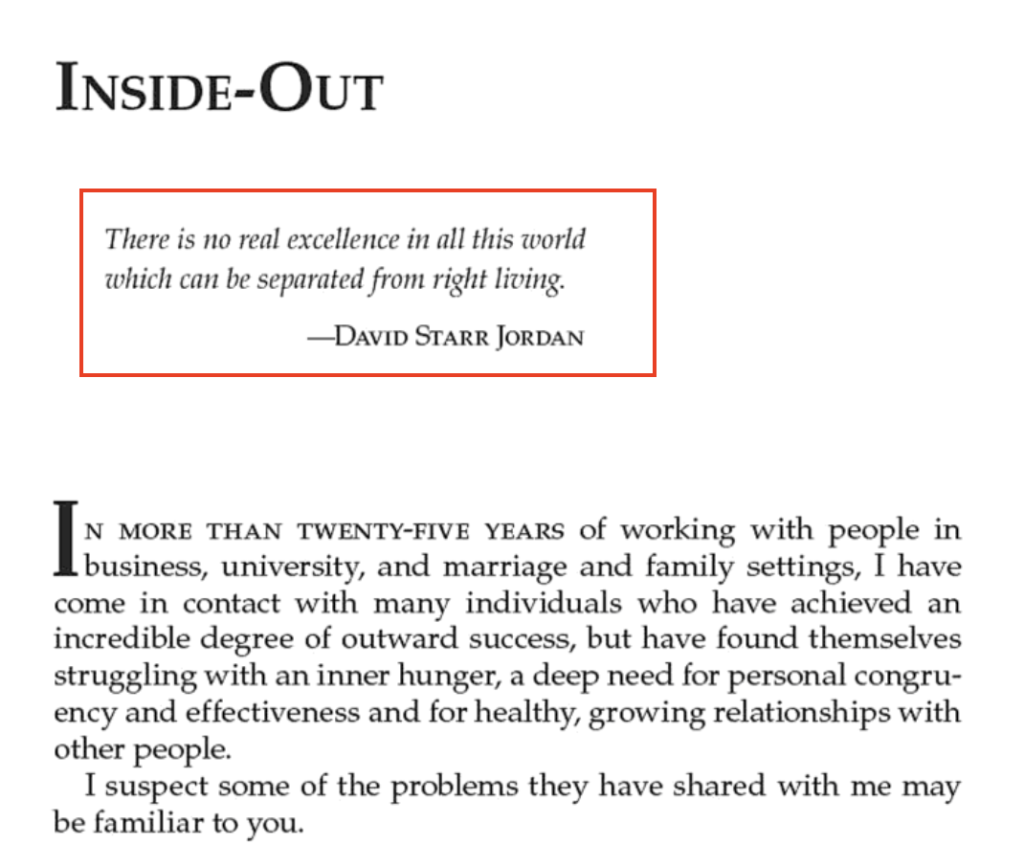
#10 – Book introduction
Most nonfiction books include an introduction to the book—a chapter before your first affiliate every bit a means to introduce yourself and your brownie or author on the discipline thing to your readers.
Your book introduction is extremely important for showing your readers why they should read the volume and how you're the person to assist them with whatever problem your volume solves.
One of the best ways to exercise this is to first establish the hurting points your book helps to solve, so get in clear how you lot, someone they don't know, can help with this issue. This is the typical strategy for writing a self-help book that actually impacts readers.
This usually involves some of your own backstory, but keep it specific to the problem at hand. Your readers don't need an entire rundown of your personal history.
#11 – Inciting incident
If you're writing fiction, yous may have come across the term "inciting incident" earlier.
What is an inciting incident?
This is an early on part of a book that'due south the signal of no return for your characters. The inciting incident is what kicks your plot into full bulldoze.
Hither are a couple examples of inciting incidents:
- Katniss volunteers to have her sister'southward place in The Hunger Games past Suzanne Collins
- Tobias enters the Tournament and gets accustomed in The Savior's Champion by Jenna Moreci
- Bella moves to Forks, where she meets Edward in biology course in Twilight past Stephanie Meyer
- Bran gets pushed off the wall in Winterfell when he catches Jaime and Cersei Lannister together in Game of Thrones past George R.R. Martin
These are all points in the novel that the characters cannot come up back from. In this instance, their lives are inverse forever, which drive the plot forward.
#12 – Sections of a book
This will mostly pertain to nonfiction authors, we we'll cover the fiction equivalent in the next section.
Some nonfiction books are written with dissimilar parts. These are usually separated into 3 parts that make upward a greater whole in the book.
For example, in the book I'm currently writing, I break it upward into iii dissever sections. Each function has its ain focus and theme just they all piece of work with 1 another to achieve a greater purpose.
Hither's an example of how the sections of my book piece of work:
- Part one – This function focuses on how your childhood impacts your adult behaviors
- Part 2 – This part aims to show readers how to move by their babyhood and become control of their "now"
- Part 3 – This department moves beyond getting command and focuses on how readers tin work toward building the future they both want and deserve despite their childhood traumas
Each part of this book has a principal focus and theme but when utilized together, they form a solution to a larger problem.
#thirteen – Human activity structure
In fiction, instead of creating separate sections like in the example above, you may dissever your work into different acts.
Virtually usually used is the three act construction.
Although this isn't required of novels, it's still quite pop to write a book with this structure, as it forms a cohesive society of events that's proven to be intriguing to readers.
A pop example of this 3 deed structure is in Sabaa Tahir's An Ember in the Ashes, featured below.
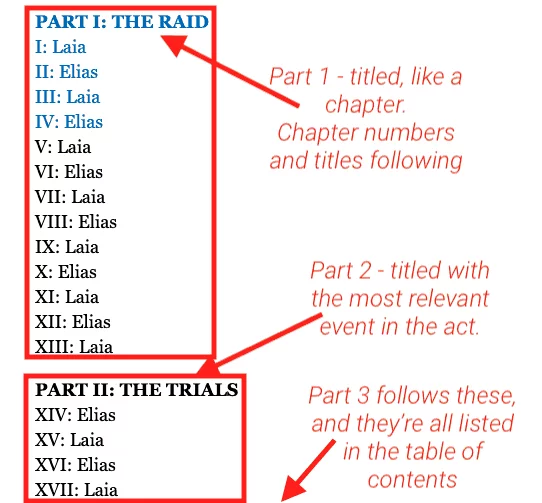
#14 – Outset slap
If y'all're familiar with our lingo around how to write a novel, or you're a student already, you may accept heard of the first and second slap.
These are pivotal points in your character'southward journeying that farther the plot and often brand their efforts more difficult.
The first slap is oftentimes the biggest setback for your graphic symbol following the inciting incident.
Here are some examples of what a "first slap" is in popular stories:
- Katniss entering the hunger games afterwards trials and tests
- Bella finding out Edward is a vampire in Twilight
- Tobias's first challenge in the tournament in The Savior's Champion by Jenna Moreci
All of these accept i thing in common: they make the lives harder for the characters.
#15 – 2nd slap
Like the kickoff slap, the second slap is a pivotal point in the novel where your character faces a downfall, most often after having a win or two nether their belt since the get-go slap.
The second slap needs to be placed shortly later on your readers take gained promise in your character's ability to succeed in whatsoever their goal is.
The idea behind this is to hook your readers once more and permit them know that information technology is not all smooth sailing for your characters throughout the rest of the book.
Oftentimes, the 2d slap is worse than the offset, where 90% of your character's promise in succeeding is lost and therefore, your readers will lose promise too. This makes them root for your character even more, increasing the amount they intendance for your character.
#16 – Climax
Nosotros all know the climax of the book is the well-nigh important office. Information technology'southward where your grapheme faces the biggest obstacle in achieving their goal in the book.
Here are a few examples of climaxes in pop books:
- Whenever Harry Potter comes face-to-face up with Voldemort in the books
- Katniss and Peeta are up against one more foe before "winning" the games in the first volume
- Bella gets taken by James and Edward has to fight to save her
The climax is the last challenge before the catastrophe, or resolution, of your volume. It is the point of the highest tension and information technology's where your graphic symbol faces the worst odds—worse than the first and second slaps.
#17 – Acknowledgements
We all take people in our lives to acknowledge for our success in writing a book.
Much like the dedication, the acknowledgments are meant to recognize impactful people in our lives. These, unlike the dedication, typically come at the end of the book and tin be written in longer, paragraph form every bit a pose to a short sentence for each.
#eighteen – Author bio
Not all books contain an writer bio in information technology, specifically fiction (unless information technology's a hardback copy).
If you're writing a nonfiction book, all the same, is a type where the author bio can be at the bottom of the dorsum folio of your book, beneath the back cover synopsis.
Hither's an example of an author bio for Sara Glashagel'southward The Route to Happy is Non I Mode.

Your author bio doesn't accept to be very long. Keep it short and simple while still showing your readers your credibility in what your volume covers.
#xix – Coming shortly / Read more
This part of a book might non matter to yous unless you have a book series or multiple books to your proper name.
The coming soon and read more than pages are used to help your readers purchase and read more of your books.
This section of a book ofttimes comes at the very finish, later on your epilogue and acknowledgments. Information technology'southward a unmarried page with the cover images of your other volume/due south, their titles, and links for your ebook copy.
This not only makes it easier for your readers to buy the next book, simply it's as well a great way to sell more books overall.
#20 – Back embrace or synopsis of a volume
I saved the best (and nigh important) for last. The back cover, also known every bit the synopsis of your volume, is past far the nigh critical for getting people to buy.
Without a good synopsis to claw readers and buy them into your book, you won't sell.
These are crucial for both fiction and nonfiction.
With your fiction synopsis, yous desire to create intrigue and show your readers that they'll get a good story. The trick is doing this with a few brusk paragraphs.
Here's an example of a fiction synopsis that works , from Fundamentals of Fiction educatee Leigh Robert'southward Endings and Beginnings: Wrak-Ayya: The Age of Shadows Book x .
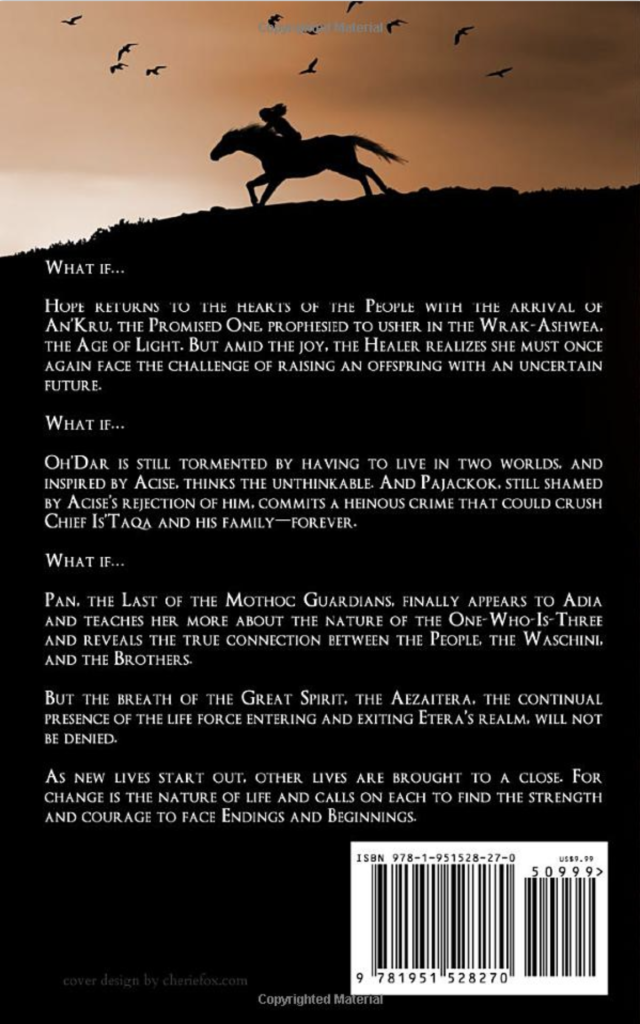
Hither's a nonfiction case of the dorsum embrace from Lisa Zelenak's Find Your Thing:

Parts of a Book in Summary
As you tin can see, these await very different, though they serve the same purpose. The back of your volume is the get-go thing someone reads in guild to decide if they want to buy your volume.
Go far curtailed, convincing, and show them the value they'll become from reading it—be that an entertaining read or a solution to their problem.
Ready To Become a Published Author?
Grab your copy of the #1 Bestselling Book on How to Go A Published Author…
Disclosure: Some of the links above may contain affiliate partnerships, meaning, at no additional cost to y'all, Self-Publishing Schoolhouse may earn a commission if you click through to make a purchase.
Source: https://self-publishingschool.com/parts-of-a-book/